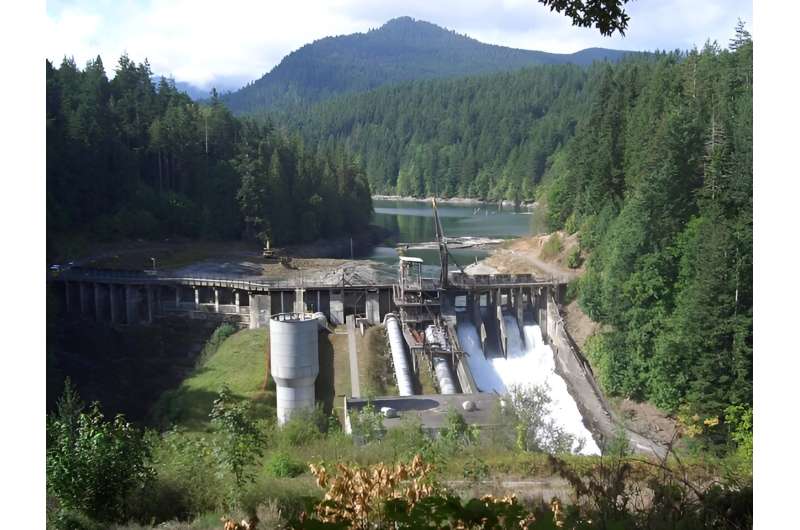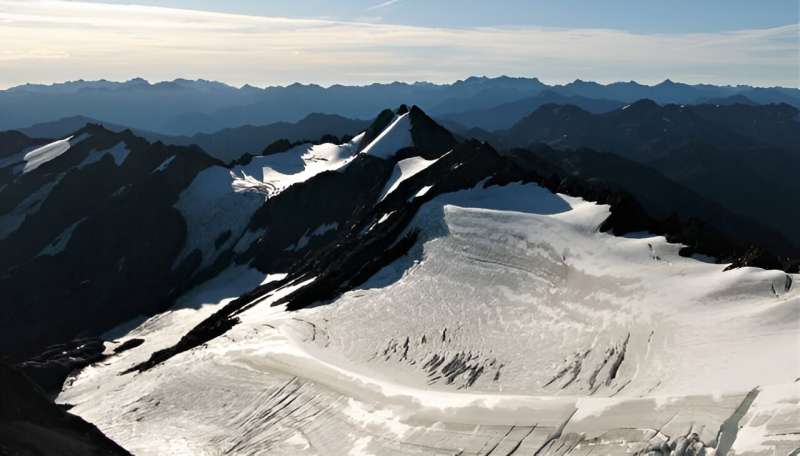This article has been reviewed according to Science X's editorial process and policies. Editors have highlighted the following attributes while ensuring the content's credibility:
fact-checked
trusted source
proofread
Dam removal spurs the return of salmon, and a local tribe's hopes of sustainable fishing

After decades of waiting for two dams to come down on the Elwha River on Washington State's Olympic Peninsula, and another decade of monitoring salmon populations, the Lower Elwha Klallam Tribe (LEKT) was finally able to open a small ceremonial and subsistence Coho salmon fishery this past October. As other salmon populations struggle to survive the impacts of climate change and human development in the Pacific Northwest, the story of the Elwha's returning Coho salmon provides hope for other communities working to save their own fish.
The Elwha River is fed by several glaciers and perennial snowfields in the Olympic mountains and is home to salmon, lamprey, otters and elk that have sustained Indigenous peoples in the region since time immemorial.
In the early 1900s, hydroelectric power greatly expanded in the Pacific Northwest, where strong rivers could be turned into energy for emerging cities. The Elwha was no exception. In 1913, the Elwha Dam was completed five miles upstream from the mouth of the river, and the Glines Canyon Dam followed suit eight miles upstream in 1927. Together the dams powered the nearby city of Port Angeles, which quickly became a logging hotspot after the hydroelectricity produced was used to power a pulp mill.
Unlike many other dams in the Pacific Northwest, the dams on the Elwha River didn't include any fish passage to help salmon migrate upstream. Consequently, salmon populations returning from the sea to spawn had only five miles of habitat—a small fraction of the 145 miles of streamside habitat along the mainstem and tributaries they previously had. This short section quickly became unsuitable for salmon since the gravel and other sediments they need to build nests and spawn built up behind the dams, and few side channels and pools of slower moving water existed in that stretch for the fish to travel.
This situation quickly led to the decimation of culturally and economically important salmon runs that Indigenous peoples like the LEKT had relied on throughout their long history in the region. Elwha sockeye salmon are now extinct, and the other six fish species populations remain critically endangered or threatened under the Endangered Species Act.
However, public opinion of the dams began to shift over the 20th century. The establishment of Olympic National Park in 1938 increased conservation efforts and awareness of the plummeting levels of salmon populations. The creation of a small hydroelectric facility on non-salmon streams nearby also rendered the hydropower created by the other dams less important. These changes paralleled national trends, with a significant uptick in dam opposition after the mid-1980s.

In 1992, Congress passed the Elwha River Ecosystem and Fisheries Restoration Act, authorizing the removal of the dams to restore salmon populations and the Elwha River ecosystem. The federal government then spent years evaluating the environmental impacts of different kinds of removal and getting together the funding and means to proceed. The dams were finally removed between 2011 and 2014, and fish populations have been slowly recovering, spurred on by restoration efforts by the LEKT, the National Park Service and local nonprofits.
Last October, for the first time in over a decade, the LEKT exercised its treaty right to harvest salmon from the Elwha River. A previous court ruling from 1974 had established that tribes had the right to fish and hunt in all their "usual and accustomed places," but the LEKT first invested time and money into salmon restoration projects and monitored the fish until numbers reached sustainable levels.
In an interview with GlacierHub, Vanessa Castle, a member of the LEKT and a natural resource technician for the tribe, explained this decision, saying "we knew it was necessary [to have the moratorium] but it was a very difficult time for us because salmon have always sustained us."
Last fall, the LEKT observed that Coho salmon populations were finally healthy enough for them to harvest a small number and feed their tribe. On October 9, 2023, the tribe held a celebration on the banks of the Elwha with singing, dancing and praying by the tribal community before officially opening the fishery.
More than 100 tribal members signed up for permits issued by the tribe on the first day, and the fishery remained open until 177 coho were caught (of the 7,000 expected to return). Families brought children who fished for salmon on the Elwha for the very first time in their lives.
Castle highlighted the magnitude of the day, saying "you could feel the anticipation coming into [the fishery] by our people."
Wider implications of this fishery
In addition to the immense spiritual value of the Coho salmon fishery on the Elwha for the LEKT, it has also provided a story of inspiration for other dam removal projects in the Pacific Northwest aimed at restoring salmon populations.
In January, crews breached the last of four dams scheduled for removal on the Klamath River in Oregon and California, and construction efforts continue to restore the basin to its free-flowing form. The Klamath Basin has seen massive fish die-offs and declines in salmon populations in the past few decades as the dams have exacerbated poor water conditions caused by droughts. Watching salmon return on the Elwha provides hope to communities on the Klamath working to restore their own populations.
In the Pacific Northwest, many salmon populations are struggling as glaciers shrink, waters warm and river habitat deteriorates. However, despite studies showing the Olympic Peninsula has lost extensive glacial coverage and is already suffering from worsening water conditions, the salmon populations on the Elwha have been improving after the dam removal and restoration efforts. Still, Chinook salmon populations are not yet at sustainable levels for a fishery to open, meaning a lot of work will need to be done. Collaborations and partnerships between Indigenous peoples and river management agencies will continue to be vital to bringing salmon back to sustainable levels.
The story of the Coho on the Elwha offers an important message: changes in land use and restoration of a critical stream habitat can help protect and restore salmon even as climate change looms. The removal of the Elwha dam was a long and arduous process, but improving salmon numbers and the return of a Coho fishery for the LEKT show that land-use changes are a key element in the fight to protect ecosystems, fish and people.
Provided by Earth Institute at Columbia University
This story is republished courtesy of Earth Institute, Columbia University http://blogs.ei.columbia.edu.




















